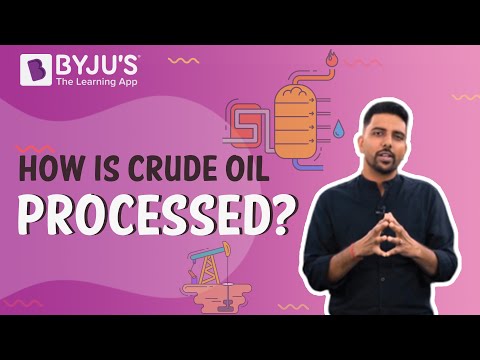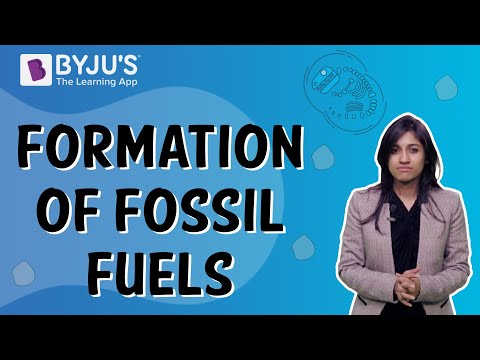Petroleum is yellow-black oil that is taken out from the earth’s crust. It is commonly called crude oil. Petroleum consists of a number of organic compounds that can be separated by the fractional distillation method. Petroleum is a fossil fuel that is formed by the action of temperature and pressure when dead remains of organisms such as algae and phytoplanktons are buried inside the earth’s sedimentary rock layers.
|
Definition: Petroleum is a liquid fuel that is found deep inside the earth’s surface. |
Petroleum Questions with Solutions
Q1: Where is the natural gas found?
- Inside the petroleum oil
- Inside the volcanic rocks
- Above the petroleum oil
- Below the petroleum oil
Answer: (c.)
Explanation: Natural gas is found just above the petroleum oil deep underground.
Q2. What is the common name given to Petroleum oil?
- Black Gold
- Yellow Gold
- Red Gold
- Brown Gold
Answer: (a.)
Explanation: Petroleum is a thick black-coloured liquid that contains expensive hydrocarbons such as kerosene oil, diesel oil and petrol oil along with natural gas found just above it. Hence, it is called as Black Gold.
Q3. During the drilling of an oil well, which product is extracted first?
- Marsh Gas
- Coal Gas
- Bio Gas
- Natural Gas
Answer: (d.)
Explanation: As natural gas exists just above the petroleum in the petroleum sources such as oil wells, natural gas comes out first.
Q4. Which process is used to separate out different hydrocarbon compounds from Petroleum?
- Distillation
- Centrifugation
- Boiling
- Fractional Distillation
Answer: (d.)
Explanation: Fractional Distillation is a method of separating a mixture of liquids that have different boiling points.
Q5. Till what temperature is the crude petroleum heated in the Fractional Distillation method to separate out the other hydrocarbon products found in it?
- 1000 oC
- 800 oC
- 600 oC
- 400-500 oC
Answer: (d.)
Explanation: The boiling point of the liquid constituents of the crude petroleum goes as high as ~370 oC. Hence, the crude petroleum is heated in the temperature range of 400-500 oC.
Q6. Which gas is formed when coal is heated in the absence of air?
Answer: The process of burning or heating coal in the absence of air is known as destructive distillation. As a result of this process, coal tar and coal gas are produced. The coal gas is a mixture of gases containing hydrogen (H2), methane (CH4) and carbon monoxide (CO).
Q7. How many different substances are found in coal tar?
Answer: Coal tar consists of as many as 10,000 different chemical substances. Out of these 10,000 chemicals, only 50% of the chemicals have been identified yet.
Q8. What is the name of the process by which coal is formed in nature?
Answer: When dead plants and animals are buried deep inside the earth’s surface, they are decomposed by the action of anaerobic bacteria. During decomposition, the constituting hydrogen and oxygen escapes from the dead plants and animals bodies. Hence, only dense carbon is left behind. This carbon content transforms into a solid mass by the action of pressure and temperature leading to the formation of coal. The process is called carbonization.
Q9. What is the main component of liquified petroleum gas (LPG)?
Answer: LPG consists of many hydrocarbon compounds that are generally limited to 3 or 4 carbons. The main constituents of LPG are liquefied Butane and isobutane.
Q10. What is a coal gas? Give its two uses.
Answer: Coal gas is a mixture of gases that are obtained from the strong heating of coal in the absence of air. The mixture of gases include some calorific gases such as methane (CH4), hydrogen (H2), carbon monoxide (CO) and ethylene (CH2=CH2) along with non-calorific gases such as carbon dioxide (CO2) and nitrogen (N2). The calorific gases are used in heating, lighting and for powering engines.
Q11. What is the difference between the processes of formation of petroleum and coal in nature?
Answer: The coal is formed when the buried dead plants and animals undergo tremendous amounts of pressure and temperature along with the action of some bacteria. However, petroleum is formed when the aquatic animals are buried in deeper layers and treated with high temperature and pressure.
Q12. What are the exhaustible natural resources?
Answer: The fuel resources such as coal, petroleum, natural gas existing in the limited amounts in nature that can be exhausted to a minimum value or even natural reserves going vacant by exceeding human mining and industrial processes are called as Exhaustible natural resources.
Q13. Which kind of coal has the lowest carbon content?
Answer: Out of the 4 different kinds of coal, Lignite is the variety that has the lowest carbon content. This coal is said to be of low quality owing to its low carbon content i.e. 65-70%. Lignite has a high moisture content and low heating value. This coal is mainly used in electricity generation.
Q14. Name the element or compound that is combined with the fuels during the formation of heat and light.
Answer: Combustion is a process of generating heat and light from the fuel. In this process, the fuel combines with the oxygen gas to undergo a combustion reaction after reaching a desired temperature needed to initiate the process known as the ignition temperature.
Q15. Why is Kerosene oil used over petrol in the oil lamps?
Answer: Kerosene oil is cheaper and less volatile than petrol. It is also more easy to handle than petrol.
Practise Questions on Petroleum
Q1. Which of the following fuel emits out more smoke and ash on burning?
- Liquid Fuel
- Solid Fuel
- Gaseous Fuel
- All of the above
Q2. What is the product of incomplete combustion of a fuel?
Q3. What is the drawdown test?
Q4. What is pseudo pressure?
Q5. What is the octane number? Comment on the efficiency of a fuel in relation to the octane number.
Click the PDF to check the answers for Practice Questions.
Download PDF
Recommended Videos
How is crude oil processed?

Formation of Fossil Fuels

Comments